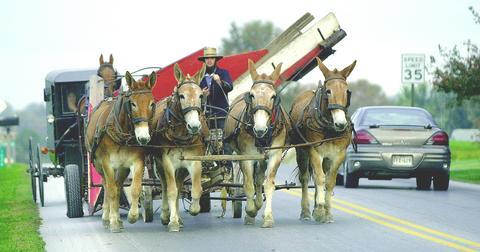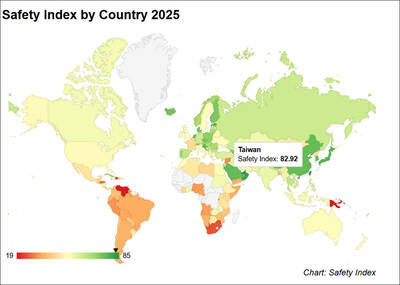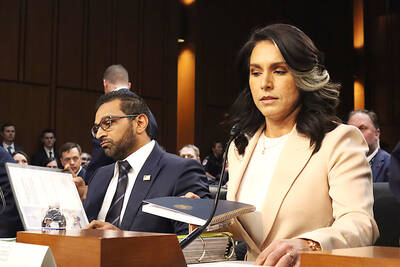Over the din of a buzzing band saw, the Amish furniture maker complained that Uncle Sam was out to get owners of woodworking shops like his simply for trying to teach Amish youths a trade.
The Amish just want to be let alone, he said, but the federal government is meddling in their lives and livelihoods by fining Amish sawmills and woodworking shops that employ teenagers, in violation of child labor laws.
"What are we supposed to do with them if they don't work here, have them stay on the street all day?" said the furniture maker, who insisted on anonymity. "I see what other teenagers do when I'm installing kitchens in people's homes. I see kids watching TV. They don't know what to do with themselves. Shouldn't they be occupied doing something worthwhile?"

PHOTO: NY TIMES
Federal law has long barred children under 18 from working in sawmills and woodworking factories, because they are so dangerous. The Amish have upset opponents of child labor by pushing Congress for an exemption based largely on religious grounds.
Amish religious rules require children to leave school after eighth grade and then learn a trade. For generations of young men, that trade was farming: the austere horse-drawn buggies traveling the backroads of Bird-in-Hand, Paradise, Intercourse and other Amish communities here in eastern Pennsylvania once passed endless miles of pasture and plowed fields.
But today the roadsides are increasingly punctuated by sawmills and woodworking shops, scores of them, producing tables, chairs, beds, gazebos, entertainment centers. As economic pressures and a scarcity of farmland fuel a shift from farming to small business, the Amish see a fast-growing need to train teenage boys in woodworking. (Teenage girls, as always, learn skills like quilting or work in retail shops.)
The Amish, who number more than 150,000 in rural communities in 25 states, predominantly Pennsylvania, Ohio and Indiana, have persuaded several allies in Congress, including Senator Arlen Specter, to introduce a bill that would let Amish children aged 14 to 17 work in sawmills and woodworking factories. Supporters say the bill, after falling short in previous Congresses, has a good chance of passing in this one, given strong backing within the ranks of the Republican majority.
Although those youths would remain barred from operating machinery, many children's advocates oppose the proposal, saying some would inevitably get too close to dangerous saws. They note that the fatality rate in sawmills is four times the rate throughout industry.
"This is the 21st century," said John R. Fraser, who headed the Labor Department's Wage and Hour Division in the Clinton administration and opposed the Amish exemption when it was first proposed in the late 1990s. "We should certainly respect and tolerate religious and cultural beliefs that date from centuries ago, but it would be irresponsible and dangerous to begin to tolerate 17th- and 18th-century practices with respect to child labor."
But while child-labor opponents seek to keep teenagers away from hazardous machinery, the Amish have an additional goal: to keep those teenagers busy with gainful work and so away from hazardous enticements.
At Furnace Road Structures, just yards from dairy barns, cornfields and bright green spreads of alfalfa, a dozen workers use saws, drills and hydraulic-powered hammers to produce 2,000 utility sheds a year. The owner looks forward to the day when his son, now 11, can begin learning the trade.
"What's my boy going to do if he can't?" the owner said. "Sit on the couch. We're going to lose our work ethic if they can't do this."
William Burkholder, an Amish sawmill operator in northwestern Pennsylvania, told a House subcommittee last week that sawmill work would be safe for teenagers because the legislation now in Congress would require them to remain far from the machinery. (The bill specifies only "sufficient distance," along with adult supervision of youths in the mill, leaving greater definition to interpretive regulation.)
Burkholder acknowledged that he lost part of a finger when, as an adult, he absent-mindedly touched a sawing machine, and noted that a 50-year-old employee recently lost most of his right arm when he tried cleaning out some wood without turning off the saw.
But in an interview he emphasized that the Amish urgently needed a way to keep boys from idleness.
"If we couldn't put our boys to work and they didn't do nothing until they were 18, they'd be absolutely worthless," he said. "We want them to be obedient and to learn a trade. If they don't, they'll be out and getting into mischief. Next thing you know, you'll have a bunch of them getting into dope and drinking and partying."
"Our kids don't do that," he said. "If you have a boy that goes to work, he feels tired and he don't want to go out howling around all night."
The Amish require plain clothing and prohibit driving, use of computers, and television- and movie-watching. They also forbid use of electricity from the power grid; diesel engines are generally allowed, to produce hydraulic and pneumatic power needed to run their businesses.
"What we're seeing is a clash of two different cultures, a clash of modern industrial culture with a more traditional, rural cottage-industry culture," said Donald B. Kraybill, a senior fellow at the Young Center for Anabaptist and Pietist Studies at nearby Elizabethtown College and author of Amish Enterprise: From Plows to Profits.
"The outside community," he continued, "has a distorted assumption of the Amish." Outsiders "don't appreciate the value of children's socialization and orientation right on the job. They think it's oppressing the children when in fact it's not. This is an incubator for Amish values and culture."
Specter, who recently toured several Amish furniture factories, says he came away convinced that Amish teenagers would not be endangered if allowed to become woodworking apprentices.
"I know where the young people would be positioned, they'll be away from the saws and the heavy action," he said. "It's been worked out to make sure that safety is assured. It requires adult supervision."
Representative Joe Pitts, a Republican who represents this area, the nation's largest Amish community, has introduced a companion bill to Specter's in the House.
"These are little family businesses trying to keep their kids in their way of life," Pitts said. "These are not sweatshops in New York City. If the Labor Department wants to find some real violations, they should find some sweatshops."
But some lawmakers remain very skeptical. "Any provision that weakens safety protections for children must be scrutinized with a careful eye," said Senator Edward M. Kennedy of Massachusetts, the senior Democrat on the Health, Education and Labor Committee.
Some critics argue that the exemption would be unconstitutional because it would treat the Amish differently from people of other religions.
"The bill would deny Amish children the very real benefits of government health and safety protection that are afforded Catholic, Baptist, Jewish or any other children of non-Amish faith," said Nicholas Clark, a child labor expert with the United Food and Commercial Workers Union.
Jim Lapp, operating manager of a non-Amish sawmill in Paradise, said the proposed exemption would give the Amish a cost advantage
"I guess an Amish 14-, 15-, 16-year-old will work for less than an 18-year-old," said Lapp, who, like others, also cites the safety issue.
"My question is whether adults will be next to them all the time," he said. "If so, that's fine. If there's not an adult around all the time, that's a problem."

AIR SUPPORT: The Ministry of National Defense thanked the US for the delivery, adding that it was an indicator of the White House’s commitment to the Taiwan Relations Act Deputy Minister of National Defense Po Horng-huei (柏鴻輝) and Representative to the US Alexander Yui on Friday attended a delivery ceremony for the first of Taiwan’s long-awaited 66 F-16C/D Block 70 jets at a Lockheed Martin Corp factory in Greenville, South Carolina. “We are so proud to be the global home of the F-16 and to support Taiwan’s air defense capabilities,” US Representative William Timmons wrote on X, alongside a photograph of Taiwanese and US officials at the event. The F-16C/D Block 70 jets Taiwan ordered have the same capabilities as aircraft that had been upgraded to F-16Vs. The batch of Lockheed Martin

GRIDLOCK: The National Fire Agency’s Special Search and Rescue team is on standby to travel to the countries to help out with the rescue effort A powerful earthquake rocked Myanmar and neighboring Thailand yesterday, killing at least three people in Bangkok and burying dozens when a high-rise building under construction collapsed. Footage shared on social media from Myanmar’s second-largest city showed widespread destruction, raising fears that many were trapped under the rubble or killed. The magnitude 7.7 earthquake, with an epicenter near Mandalay in Myanmar, struck at midday and was followed by a strong magnitude 6.4 aftershock. The extent of death, injury and destruction — especially in Myanmar, which is embroiled in a civil war and where information is tightly controlled at the best of times —

Taiwan was ranked the fourth-safest country in the world with a score of 82.9, trailing only Andorra, the United Arab Emirates and Qatar in Numbeo’s Safety Index by Country report. Taiwan’s score improved by 0.1 points compared with last year’s mid-year report, which had Taiwan fourth with a score of 82.8. However, both scores were lower than in last year’s first review, when Taiwan scored 83.3, and are a long way from when Taiwan was named the second-safest country in the world in 2021, scoring 84.8. Taiwan ranked higher than Singapore in ninth with a score of 77.4 and Japan in 10th with

SECURITY RISK: If there is a conflict between China and Taiwan, ‘there would likely be significant consequences to global economic and security interests,’ it said China remains the top military and cyber threat to the US and continues to make progress on capabilities to seize Taiwan, a report by US intelligence agencies said on Tuesday. The report provides an overview of the “collective insights” of top US intelligence agencies about the security threats to the US posed by foreign nations and criminal organizations. In its Annual Threat Assessment, the agencies divided threats facing the US into two broad categories, “nonstate transnational criminals and terrorists” and “major state actors,” with China, Russia, Iran and North Korea named. Of those countries, “China presents the most comprehensive and robust military threat